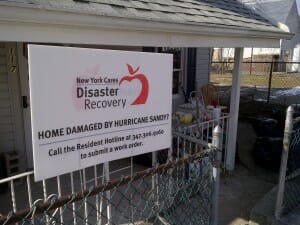Volunteers’ work is critical in the aftermath of Superstorm Sandy… and all Disasters

Today's post is written by Jeff Hoffman, a board member of Points of Light and president of Jeff Hoffman & Associates, a global philanthropy and civic engagement firm. This content is republished from the Jeff Hoffman & Associates blog on Feb. 12, 2013.
It has been three months since Superstorm Sandy hit the easternseaboard. Last week I had a moving experience on the Rockaway peninsula, and in Brooklyn, seeing firsthand the devastation and how volunteers continue to be part of the solution helping these communities rebuild. As the storm approached, Points of Light dispatched their director of disaster services to FEMA headquarters. When the storm surged it became apparent what areas were the hardest hit. The Red Cross and many other organizations, along with government agencies and businesses, were poised for the relief efforts. Volunteers, both trained and not (unaffiliated), were responding. One of my clients’ subsidiaries, Southern California Edison, sent trucks, equipment and linemen along with staff from the community investment department, to help. Points of Light and its HandsOn Network (Volunteer Centers) were also responding. Nine affiliates through the region were, and are, active in the various phases of a disaster from initial relief, to recovery and resiliency.
My tour was through areas serviced by New York Cares. We drove the length of the Rockaway’s, visited their command center (very cold trailers), and homes that they were being mucked out. One home was being scrubbed for mold. After the home’s contents and dry wall had been removed, the studs were scrubbed so as the house could then be rebuilt. This is a tedious process and being done by volunteers. Many of the areas I visited are home to lower income and the elderly. Without the support of volunteers, many would not be able to rebuild, or rebuild as quickly. Volunteers have been providing many services in addition to those mentioned here. Tutoring children when the schools were closed so as they would not fall behind and now helping with income tax preparation as the disaster will make their returns far more complicated, are both examples.
Points of Light is building its infrastructure to better support the 250 HandsOn Network affiliates across the US, plus those outside the US, prepare and respond. Next time there is a disaster and you want to help, or be proactive with your support and help with the preparedness efforts, consider funding volunteer infrastructure. It’s a very important, and often overlooked, element of disasters. http://www.pointsoflight.org/programs/disaster http://www.newyorkcares.org/
